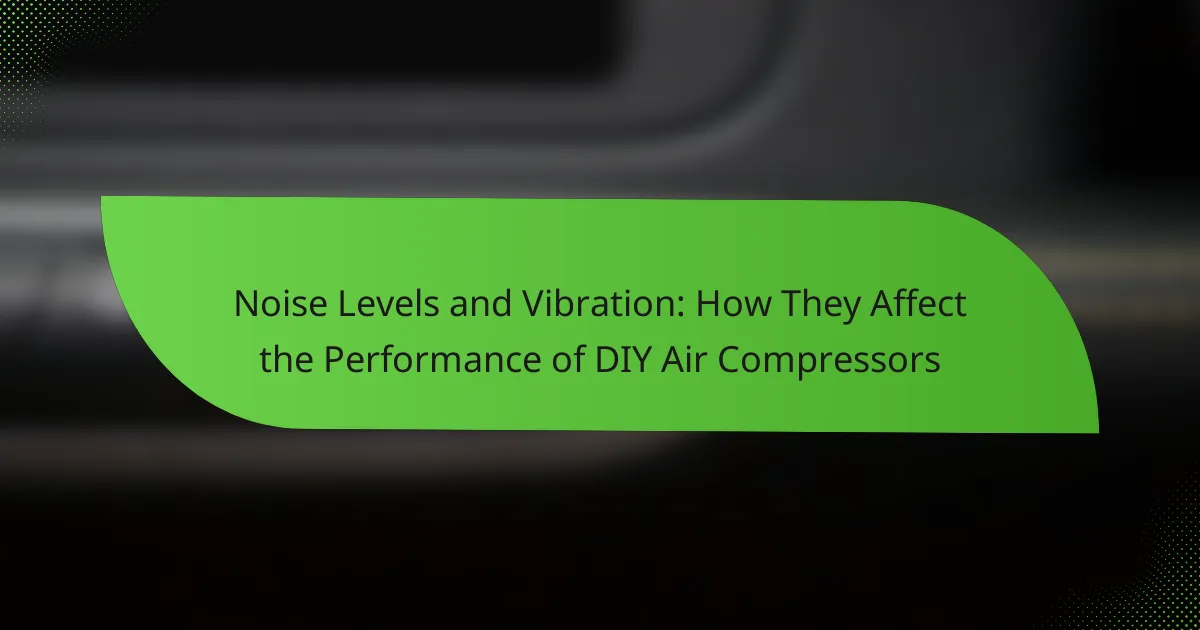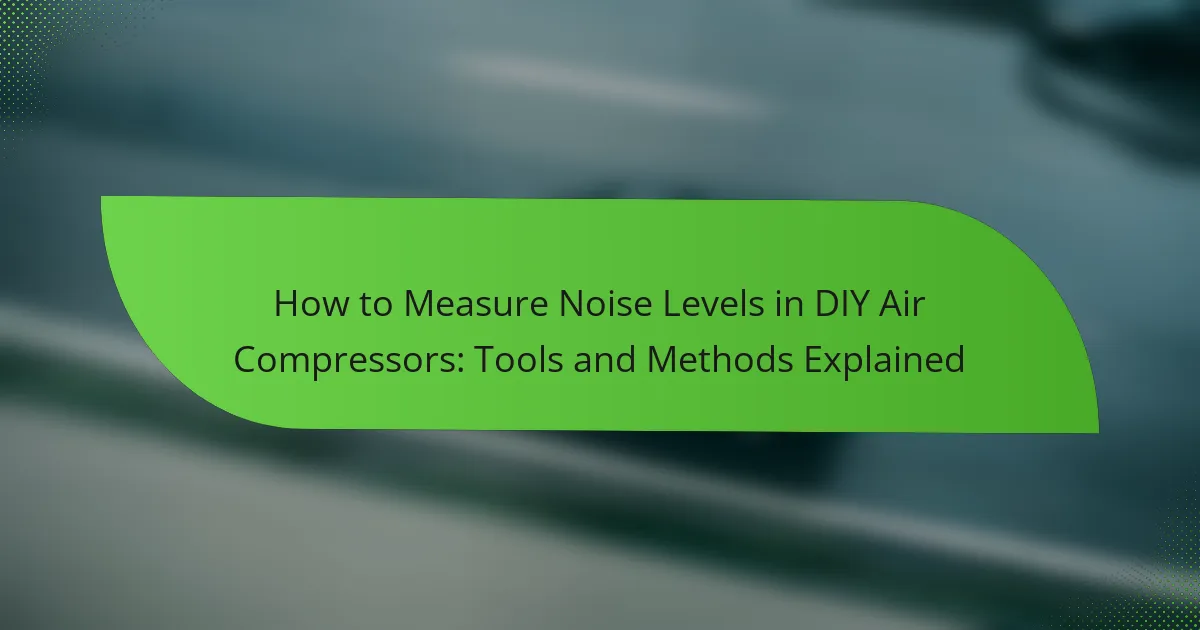Noise levels significantly affect the success and safety of DIY projects, with high decibel levels leading to distractions, mistakes, and potential hearing damage. Air compressors, essential tools for various DIY tasks, typically operate between 60 to 90 decibels, making it crucial to select models with lower noise ratings for residential use. Compressors labeled as “low noise” or “quiet,” usually operating below 70 decibels, enhance focus and comfort while minimizing disturbances. Additionally, understanding the compressor’s power and tank size is vital for efficient use, as larger tanks allow for extended operation. This article explores the impact of noise levels on DIY projects and provides guidelines for choosing the right air compressor based on noise considerations.

What is the Impact of Noise Levels on DIY Projects?
Noise levels significantly impact DIY projects. High noise levels can lead to distractions and reduced concentration. This may result in mistakes or accidents during the project. Additionally, prolonged exposure to loud noises can cause hearing damage. According to the CDC, noise levels above 85 decibels can be harmful over time. Thus, choosing quieter tools can enhance focus and safety. Selecting an air compressor with a lower decibel rating is advisable. This choice can improve the overall experience of DIY projects.
How do noise levels affect the overall experience of DIY projects?
Noise levels significantly impact the overall experience of DIY projects. High noise levels can lead to increased stress and fatigue. This can reduce focus and efficiency during tasks. Studies show that excessive noise can cause irritability and distraction. In contrast, moderate noise levels may enhance creativity and motivation. Choosing quieter tools can improve the enjoyment of DIY projects. For example, air compressors with lower decibel ratings are more user-friendly. This can lead to a more pleasant working environment. Overall, managing noise levels is crucial for a positive DIY experience.
What psychological effects can high noise levels have during DIY activities?
High noise levels during DIY activities can lead to increased stress and anxiety. Exposure to loud sounds can trigger the body’s fight-or-flight response. This response can elevate heart rates and lead to feelings of unease. Research shows that consistent exposure to high noise levels can impair cognitive function. It can also reduce attention span and hinder problem-solving abilities. A study published in the Journal of Environmental Psychology found that noise can negatively impact mood and overall satisfaction with tasks. Furthermore, high noise levels can lead to frustration and decreased motivation. These psychological effects may ultimately affect the quality of the DIY project being undertaken.
How do noise levels influence the quality of work in DIY projects?
Noise levels significantly influence the quality of work in DIY projects. High noise levels can lead to distractions, making it difficult to concentrate. This can result in mistakes during tasks that require precision. Research indicates that excessive noise can increase stress levels, negatively impacting overall performance. According to a study by the World Health Organization, prolonged exposure to high noise levels can lead to decreased productivity. Furthermore, noise can hinder communication, which is crucial when collaborating on projects. Lower noise levels, on the other hand, create a more conducive environment for focus and accuracy. In summary, managing noise levels is essential for achieving high-quality results in DIY endeavors.
Why is it important to consider noise levels when choosing tools?
Considering noise levels when choosing tools is important for several reasons. High noise levels can lead to hearing damage over time. Prolonged exposure to sounds above 85 decibels can cause permanent hearing loss. Additionally, excessive noise can create a stressful work environment. This can reduce concentration and productivity during DIY projects. Tools that operate at lower noise levels are often more comfortable to use. They also minimize disturbance to others nearby. Therefore, selecting quieter tools enhances both personal safety and overall project experience.
What are the potential health risks associated with prolonged exposure to noise?
Prolonged exposure to noise can lead to several health risks. These risks include hearing loss, which occurs due to damage to the hair cells in the inner ear. Chronic noise exposure can also result in increased stress levels. Elevated stress may contribute to cardiovascular issues, such as hypertension. Additionally, prolonged noise exposure can disrupt sleep patterns, leading to fatigue and decreased cognitive performance. Research indicates that individuals exposed to noise levels above 85 decibels are at greater risk for these health issues. The World Health Organization highlights that environmental noise can significantly impact public health.
How can noise levels lead to distractions during DIY tasks?
High noise levels can lead to distractions during DIY tasks. Excessive noise disrupts concentration and focus. It can cause increased stress and fatigue. Studies show that loud environments reduce productivity. Noise can mask important sounds, such as tool operation or safety warnings. This distraction can lead to mistakes or accidents. Additionally, high noise levels can hinder communication among team members. Ultimately, managing noise is crucial for effective DIY project execution.

What should you know about Air Compressors for DIY Projects?
Air compressors are essential tools for various DIY projects. They provide compressed air for powering tools like nail guns, spray guns, and air wrenches. Understanding the noise levels of air compressors is crucial for selecting the right model. Most air compressors operate between 60 to 90 decibels. Higher noise levels can be disruptive in residential areas. Choosing a quieter model can enhance the DIY experience. Look for compressors labeled as “low noise” or “quiet.” These models typically operate below 70 decibels. Additionally, consider the compressor’s power and tank size for efficiency. A larger tank allows for longer operation without frequent cycling.
How do air compressors function in DIY applications?
Air compressors function in DIY applications by converting power into potential energy stored in pressurized air. They draw in ambient air and compress it using a piston or rotary mechanism. This compressed air is then stored in a tank for later use. DIY enthusiasts utilize air compressors for various tasks such as powering pneumatic tools, inflating tires, and spraying paint. The efficiency of an air compressor is often measured by its CFM (cubic feet per minute) rating, which indicates the volume of air it can deliver. Noise levels from air compressors can vary significantly, impacting the comfort of the working environment. Selecting a quieter model can enhance the DIY experience, especially in residential areas.
What are the key components of an air compressor?
The key components of an air compressor include the motor, pump, tank, pressure switch, and regulator. The motor powers the compressor, converting electrical energy into mechanical energy. The pump compresses the air, increasing its pressure for storage. The tank stores the compressed air for later use, providing a reserve supply. The pressure switch automatically turns the motor on and off to maintain desired pressure levels. The regulator controls the output pressure of the compressed air, ensuring it meets the requirements of various tools. Each component works together to ensure the efficient operation of the air compressor in various DIY projects.
How does the power rating of an air compressor relate to its performance?
The power rating of an air compressor directly influences its performance. Higher power ratings typically result in greater airflow and pressure output. This allows for more efficient operation of pneumatic tools. For example, a compressor rated at 5 horsepower can deliver around 17 CFM at 90 PSI. This is suitable for heavy-duty applications. Conversely, a lower power rating may limit the compressor’s capability. Air compressors with lower ratings may struggle with demanding tasks. Thus, the power rating is a key factor in determining the effectiveness of an air compressor for specific projects.
What types of air compressors are available for DIY use?
The types of air compressors available for DIY use include pancake, hot dog, twin-stack, and portable electric compressors. Pancake compressors are compact and lightweight, ideal for small tasks like inflating tires. Hot dog compressors have a cylindrical shape and are designed for moderate air supply needs. Twin-stack compressors offer a larger tank capacity for extended use, suitable for air tools. Portable electric compressors are versatile and can be used for various DIY projects. Each type is designed to cater to different project requirements and noise levels, ensuring suitability for home use.
What are the differences between oil-lubricated and oil-free air compressors?
Oil-lubricated air compressors use oil to reduce friction and wear in their components. This results in quieter operation and longer lifespan. Oil-free air compressors do not use oil, making them cleaner and maintenance-free. However, they may produce more noise and have a shorter lifespan compared to oil-lubricated models. Oil-lubricated compressors typically provide better performance for heavy-duty tasks. In contrast, oil-free compressors are ideal for light-duty applications where cleanliness is essential. The choice between the two depends on specific project needs and noise level considerations.
Which air compressor types are best suited for specific DIY tasks?
Pancake compressors are best for light DIY tasks like inflating tires and powering small tools. They are compact and portable, making them ideal for home use. Their noise levels are moderate, which is suitable for residential areas.
Hot dog compressors are also suitable for similar light tasks but can power slightly larger tools. They offer a larger tank than pancake compressors, providing longer run times. However, they can be noisier, which may not be ideal for quiet neighborhoods.
Twin-stack compressors are effective for moderate tasks such as nail guns and staplers. They have a higher PSI output and larger tank capacity. This type maintains performance while still being manageable in noise levels.
Wheelbarrow compressors are designed for heavy-duty tasks like spray painting and running pneumatic tools. They are larger and can be quite loud. However, they provide the necessary power for demanding projects.
Oil-free compressors are low maintenance and suitable for tasks requiring portability. They are quieter than oil-lubricated models but may not support heavy-duty applications.
Overall, selecting the right compressor depends on the specific DIY task and the noise tolerance of the environment.

How do you choose the right air compressor based on noise levels?
To choose the right air compressor based on noise levels, first identify the decibel (dB) rating of the compressor. Compressors typically range from 60 dB to over 90 dB. A lower dB rating indicates a quieter operation. For residential use or DIY projects, select a compressor with a rating below 70 dB for minimal disturbance.
Consider the compressor’s application. For indoor tasks, quieter models are preferable. Look for models designed with noise-reducing features, such as sound insulation or low RPM motors.
Research shows that noise levels can impact work efficiency and comfort. According to the CDC, prolonged exposure to noise above 70 dB can lead to hearing loss. Thus, selecting a quieter air compressor not only enhances comfort but also protects hearing health.
What noise level ratings should you consider when selecting an air compressor?
When selecting an air compressor, consider noise level ratings measured in decibels (dB). A lower dB rating indicates a quieter compressor. Compressors rated between 60-70 dB are generally suitable for home use. Those above 70 dB can be disruptive in residential areas. For comparison, normal conversation is around 60 dB. This means that compressors above this level may require hearing protection for prolonged use. Additionally, some manufacturers provide sound ratings for specific models, which can help in making an informed choice.
How do decibel levels correlate with comfort during DIY projects?
Decibel levels significantly correlate with comfort during DIY projects. Higher decibel levels can lead to discomfort and stress. Prolonged exposure to sounds above 85 decibels can cause hearing damage and fatigue. Comfortable noise levels typically range from 60 to 70 decibels. At these levels, individuals can focus without distraction. Studies show that environments with lower noise levels improve concentration and overall satisfaction. Therefore, selecting tools with lower decibel ratings enhances the DIY experience. This correlation emphasizes the importance of choosing quieter equipment for comfort and safety.
What are the recommended noise levels for residential use?
The recommended noise levels for residential use are typically between 30 to 50 decibels (dB). This range is considered acceptable for maintaining a comfortable living environment. Noise levels above 50 dB can lead to disturbances and potential health issues. For reference, normal conversation is around 60 dB, which is above the recommended range. The World Health Organization suggests that noise levels above 55 dB can negatively impact sleep and health. Therefore, it is essential to choose appliances and tools that operate within this recommended noise level for residential settings.
What are some tips for minimizing noise when using air compressors?
To minimize noise when using air compressors, consider several effective strategies. First, choose a quieter model. Some air compressors are designed with noise-reduction features. Second, place the compressor on a solid surface. A stable base reduces vibrations that contribute to noise. Third, use soundproofing materials around the compressor. Acoustic panels or blankets can absorb sound waves. Fourth, maintain the compressor regularly. Proper maintenance can prevent excessive noise from worn parts. Fifth, operate the compressor in a well-ventilated area. This can help disperse sound more effectively. Finally, consider using a sound enclosure. Enclosures can significantly reduce noise levels. These strategies collectively contribute to a quieter air compressor operation, enhancing the overall DIY project experience.
How can sound-dampening accessories improve your DIY experience?
Sound-dampening accessories can significantly enhance your DIY experience by reducing noise levels during projects. They minimize distractions, allowing for greater focus and concentration. Improved focus leads to higher quality work and fewer mistakes. Additionally, these accessories protect your hearing from prolonged exposure to loud sounds. According to the CDC, consistent exposure to noise levels above 85 decibels can cause hearing loss. Using sound-dampening accessories can keep noise levels within a safer range. This creates a more comfortable working environment, which can increase productivity. Overall, sound-dampening accessories contribute to a safer and more effective DIY experience.
What practices can help reduce noise pollution during DIY projects?
Using quieter tools and equipment can significantly reduce noise pollution during DIY projects. Select electric tools over gas-powered ones, as they tend to operate more quietly. Employ sound-dampening materials, such as rugs or acoustic panels, in the workspace to absorb sound. Schedule projects during daytime hours to minimize disturbance to neighbors. Use noise barriers, like fences or walls, to block sound from escaping the work area. Opt for tools with built-in noise reduction features, which can lower decibel levels. Regular maintenance of tools can also ensure they operate efficiently and quietly. Finally, consider using manual tools when feasible, as they typically generate less noise than power tools.
The main entity of this article is noise levels and their impact on DIY projects, specifically in relation to choosing the right air compressor. The article explores how high noise levels can lead to distractions, reduced concentration, and potential health risks such as hearing damage and increased stress. It emphasizes the importance of selecting quieter air compressors to enhance focus, safety, and overall project quality. Additionally, it provides insights into different types of air compressors, their noise ratings, and strategies for minimizing noise pollution during DIY activities.



